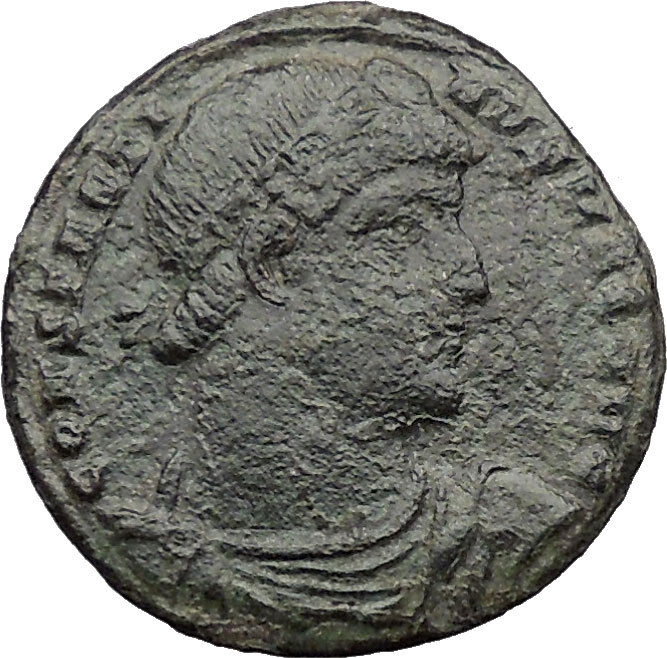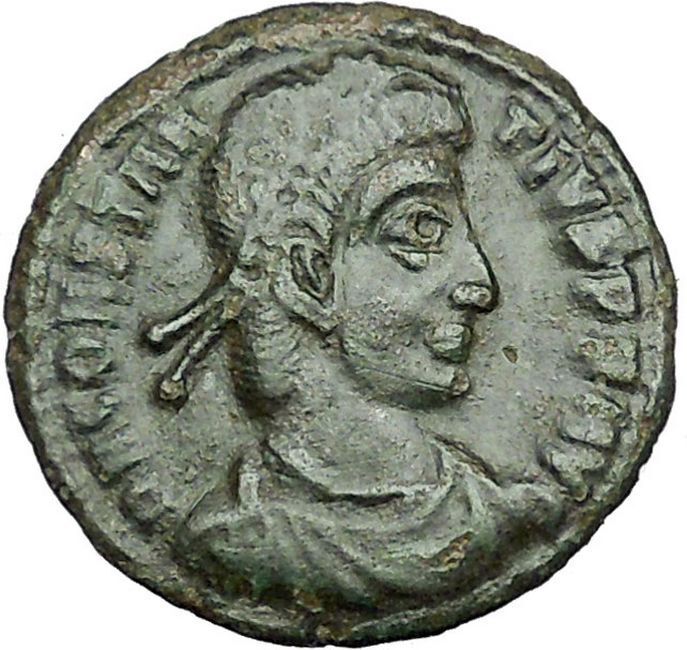|
Valerian II – Roman Caesar: 256-258 A.D.
Billon Silver Antoninianus (Double-denarius) 21mm (4.30 grams) Antioch mint, struck 254-255 A.D.
Reference: RIC 49; C 67
VALERIANVS NOBIL CAES, Radiate, draped bust right.
PRINC IVVENTVTIS, Valerian standing left, crowning trophy.
You are bidding on the exact item pictured, provided with a Certificate of Authenticity and Lifetime Guarantee of Authenticity.
Billon is an alloy of a precious metal (most commonly silver) with a majority base metal content (such as copper). It is used chiefly for making coins, medals, and token coins. The word comes from the French bille. The use of billon coins dates from ancient Greece through the Middle Ages. During the 6th and 5th centuries BC, some cities on Lesbos Island used coins made of 60% copper and 40% silver. Billon coins are perhaps best known from the Roman Empire, where progressive debasements of the Roman denarius and the Roman provincial tetradrachm.
 A trophy is a reward for a specific achievement, and serves as recognition or evidence of merit. A tropaion (Latin: tropaeum), whence English “trophy” is an ancient Greek and later Roman monument set up to commemorate a victory over one’s foes. Typically this takes the shape of a tree, sometimes with a pair of arm-like branches (or, in later times, a pair of stakes set crosswise) upon which is hung the armour of a defeated and dead foe. The tropaion is then dedicated to a god in thanksgiving for the victory. A trophy is a reward for a specific achievement, and serves as recognition or evidence of merit. A tropaion (Latin: tropaeum), whence English “trophy” is an ancient Greek and later Roman monument set up to commemorate a victory over one’s foes. Typically this takes the shape of a tree, sometimes with a pair of arm-like branches (or, in later times, a pair of stakes set crosswise) upon which is hung the armour of a defeated and dead foe. The tropaion is then dedicated to a god in thanksgiving for the victory.
Greece
In the Greek city-states of the Archaic period, the tropaion would be set up on the battlefield itself, usually at the site of the “turning point” (Gk. tropê) at which the routed enemy’s phalanx broke, turned and ran. It would be dressed in the typical hoplite panoply of the period, including (at different times), a helmet, cuirass (either of bronze or linen), and a number of shields,etc, would be piled about the base. It remained on the battlefield until the following season’s campaigns (since battles were often fought in the same, relatively few plains amid Greece’s numerous mountains), where it might be replaced with a new trophy.
In later eras in the Greek world, these tropaia might be vowed at the battle-site, but in fact erected at pan-Hellenic sanctuaries such as Olympia or Delphi to further increase the prestige of the victorious state.
The significance of the monument is a ritualistic notification of “victory” to the defeated enemies. Since warfare in the Greek world was largely a ritualistic affair in the archaic hoplite-age (see Hanson, The Western Way of War for further elaboration of this idea), the monument is used to reinforce the symbolic capital of the victory in the Greek community.
Ancient sources attest to the great deal of significance that early Greek cities placed upon symbols and ritual as linked to warfare–the story involving the bones of Orestes, for example, in Herodotus 1 which go beyond the ritualistic properties to even magically ‘guaranteeing’ the Spartan victory, displays the same sort of interest in objects and symbols of power as they relate to military success or failure.
Rome
The tropaeum in Rome, on the other hand, would probably not be set up on the battle-site itself, but rather displayed prominently in the city of Rome. Romans were less concerned about impressing foreign powers or military rivals than they were in using military success to further their own political careers inside the city, especially during the later years of the Republic. A tropaeum displayed on the battlefield does not win votes, but one brought back and displayed as part of a triumph can impress the citizens (who might then vote in future elections in favor of the conqueror) or the nobles (with whom most aristocratic Romans of the Republican period were in a constant struggle for prestige).
The symbolism of the tropaeum became so well known that in later eras, Romans began to simply display images of them upon sculpted reliefs (see image and Tropaeum Traiani), to leave a permanent trace of the victory in question rather than the temporary monument of the tropaeum itself.
Originally the word trophy, derived from the Latin tropaion, referred to arms, standards, other property, or human captives and body parts (e.g. headhunting) captured in battle. These war trophies commemorated the military victories of a state, army or individual combatant. In modern warfare trophy taking is discouraged, but this sense of the word is reflected in hunting trophies and human trophy collecting by serial killers.
Trophies have marked victories since ancient times. The word trophy coined in English in 1550, was derived from the French trophée in 1513, “a prize of war”, from Old French trophee, from Latin trophaeum, monument to victory, variant of tropaeum, which in turn is the latinisation of the Greek τρόπαιον (tropaion), the neuter of τροπαῖος (tropaios), “of defeat” or “for defeat”, but generally “of a turning” or “of a change”, from τροπή (tropē), “a turn, a change” and that from the verb τρέπω (trepo), “to turn, to alter”.
In ancient Greece, trophies were made on the battlefields of victorious battles, from captured arms and standards, and were hung upon a tree or a large stake made to resemble a warrior. Often, these ancient trophies were inscribed with a story of the battle and were dedicated to various gods. Trophies made about naval victories sometimes consisted of entire ships (or what remained of them) laid out on the beach. To destroy a trophy was considered a sacrilege.
The ancient Romans kept their trophies closer to home. The Romans built magnificent trophies in Rome, including columns and arches atop a foundation. Most of the stone trophies that once adorned huge stone memorials in Rome have been long since stolen.
Valerian II – Roman Caesar: 256-258 A.D.
| Son of Gallienus and Salonina | Brother of Saloninus | Grandson of Valerian I and Mariniana |
Publius Licinius Cornelius Valerianus (died 257 or 258), also known as Valerian II, was the eldest son of Roman Emperor Gallienus and Augusta Cornelia Salonina who was of Greek origin and grandson of the Emperor Valerian who was of a noble and traditional senatorial family.
Shortly after his acclamation as Emperor (Augustus) Valerian made Gallienus his co-Emperor and his grandson, Valerian, Caesar, in 256. (For a discussion of the dynastic politics that motivated this process, see the related article on Saloninus).
The young Caesar was then established in Sirmium to represent the Licinius family in the government of the troubled Illyrian provinces while Gallienus transferred his attentions to Germany to deal with barbarian incursions into Gaul. Because of his youth (he was probably no more than fifteen at the time), Valerian was put under the guardianship of Ingenuus, who seems to have held an extraordinary command as governor of the Illyrian provinces, i.e. Upper and Lower Pannonia and Upper and Lower Moesia.
It is reported that Salonina was not happy with this arrangement. Although she could not publicly dispute the decisions of Valerian, the pater patriae which had been formally agreed by her husband, Gallienus, she suspected Ingenuus’s motives and asked an officer called Valentinus, otherwise unknown, to keep an eye on him. Despite this precaution, Valerian died in late 257-early 258 in circumstances sufficiently suspicious for Gallienus to attempt to demote Ingenuus. It was this action that sparked the attempted usurpation of the Empire by Ingenuus, who had widespread support among the Illyrian garrisons and the provincial establishment.
As in case of his brother, Saloninus, who was later made Caesar in Gaul, the little we know of Valerian’s short reign in Illyria is indicative of the chaotic situation that prevailed on the northern frontiers of the Empire under Valerian and Gallienus. It seems to show that the mere presence of a member of the Imperial House in a troubled region was not sufficient to assuage local fears of being neglected by the distant Emperor. The local Caesar had to wield undisputed authority in his region and command the resources and the experience to deal with the internal and external threats to its security. Diocletian and Maximian seem to have understood this when they set up Constantius Chlorus and Galerius as Caesars in Gaul and Illyria respectively some thirty-five years later.
|





 A trophy is a reward for a specific achievement, and serves as recognition or evidence of merit. A tropaion (Latin: tropaeum), whence English “trophy” is an ancient Greek and later Roman monument set up to commemorate a victory over one’s foes. Typically this takes the shape of a tree, sometimes with a pair of arm-like branches (or, in later times, a pair of stakes set crosswise) upon which is hung the armour of a defeated and dead foe. The tropaion is then dedicated to a god in thanksgiving for the victory.
A trophy is a reward for a specific achievement, and serves as recognition or evidence of merit. A tropaion (Latin: tropaeum), whence English “trophy” is an ancient Greek and later Roman monument set up to commemorate a victory over one’s foes. Typically this takes the shape of a tree, sometimes with a pair of arm-like branches (or, in later times, a pair of stakes set crosswise) upon which is hung the armour of a defeated and dead foe. The tropaion is then dedicated to a god in thanksgiving for the victory.




